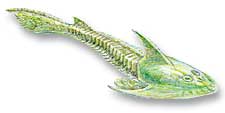Fish
Fish are cold blooded creatures that inhabit all kinds of water bodies from small ponds to the deep sea. They are vertebrates, with a back-bone made of cartilage or bone and a braincase protecting the brain; they swim using fins; and take oxygen from the water by means of gills (although some also have lungs).


These features distinguish them from amphibians and reptiles, which have lungs and limbs rather than gills and fins; and whales and dolphins which are warm blooded mammals with lungs. Since the Late Cambrian, fish have evolved into thousands of species and today they form over half of all living vertebrates.
Jawless fish, which resemble living lampreys, first appeared in the early Cambrian and later evolved into many types, including Loganellia, above right and Jamoytius. Some (e.g. Cephalaspis, below right) were protected by thick scales or by bony head-shields. They did not have bones within their bodies but they did have a notochord, or primitive spinal column, and so fossils are rare.


One group, the conodonts, were for decades known only from teeth found in Palaeozoic rocks, but very rare fossils of their soft, eel-like body have now been found. Jawless fish ate tiny organisms and food particles from the sea floor and some may have sucked blood.

The last of the coelacanths were believed to have become extinct in the late Cretaceous, about 70 million years ago. But in 1938, to the amazement of scientists, a living specimen, called Latimeria, was caught off the Comoro Islands, in the Indian Ocean.

More recently these 'living fossils' have also been found off Indonesia. Islanders have known of these fish for many years, and used to use the rough skin as paper.